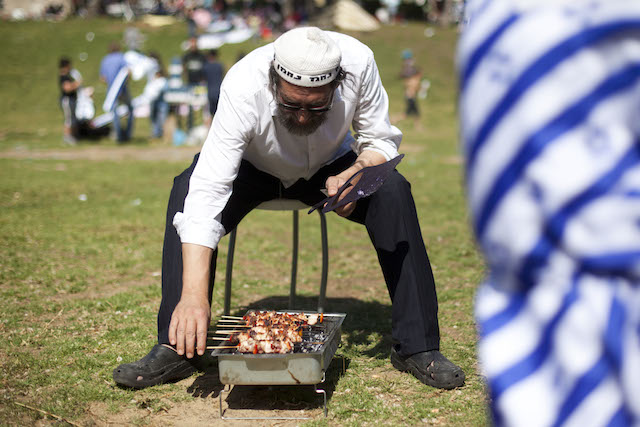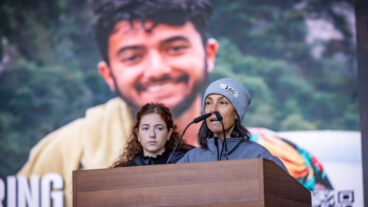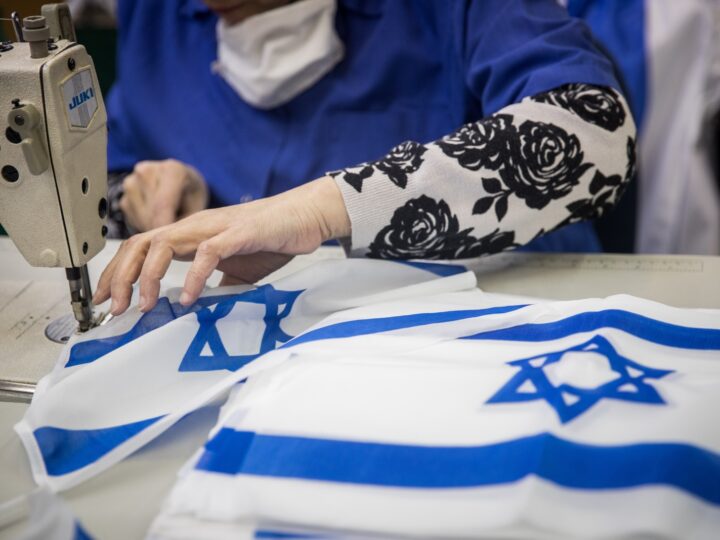On May 5-6, the state of Israel’s 66th anniversary, every park and public space will be brimming with barbecues. But it’s not quite the same as July Fourth cookouts in the United States. We’ve put a peculiarly Israeli spin on our Independence Day celebrations.
How will you know when this 66-year-old country marks its independence? Look around for these seven sure signs.
The mangal
Without a doubt, the most prominent feature of Yom Ha’atzmaut (Independence Day) in Israel is the mangal, or charcoal-grill barbecue.
According to the Ministry of Agriculture, the average Israeli eats 1.7 kilos (3.7 pounds) of meat each month. During the month starting with Passover, however, the average jumps to 2.3 kilos per person.
This translates roughly to 15,000 tons of beef al ha’esh (on the fire) during the month of Independence Day – mainly entrecote, sirloin and tenderloin (or kebabs and burgers for those on a budget). Tons of chicken – mainly the thigh-meat called pargiyot — will also be cooking on the grill.

Sales of hummus — the chickpea dip that accompanies just about every Israel meal — also soar just before Independence Day, moving off store shelves at a clip of about 25 percent more than usual.
Many Israelis head to the nation’s parks and forests for their barbecues. In 2012, more than one million visitors (from a population of just over eight million) filled KKL-JNF’s forests and parks on Independence Day – that’s about one in eight people, and the figure is growing every year.
One million people leave a lot of garbage, too. At the end of Yom Ha’atzmaut in 2012, more than 400 tons of garbage were collected.
For the growing number of Israelis adopting a plant-based diet, Vegan-Friendly Israel is hosting its first meat-free mangal. An annual vegan picnic takes place in Tel Aviv’s Yarkon Park.
The nafnaf
There is no such thing as a mangal without a nafnaf, a plastic or cardboard fan to keep the coals glowing. (The word comes from the Hebrew for “waving” or “flapping.”) Never mind that cookouts elsewhere in the world manage successfully without these handheld devices. An Israeli would never put anything on the grill without a nafnaf at the ready.


Torch lighting
Every year as sunset falls on the eve of Independence Day, a torch-lighting ceremony at Jerusalem’s Mount Herzl kicks off the celebration.

For Israel’s 66th anniversary, the accomplished Israelis chosen to light the 12 torches – symbolizing the 12 tribes of Israel — will all be women. They include actress Miriam Zohar, haredi higher education pioneer Adina Bar Shalom, Major General Orna Barbivai and Hindiya Suliman, who started a women’s cooperative crafts industry in her the Bedouin village.
International Bible Contest for Jewish Youth
The 51st Chidon Ha-Tanach-International Bible Contest for Jewish Youth will be televised live from the Jerusalem Theater on Independence Day. Winners of national rounds in their home countries are treated to a week of sightseeing before the contest, which features celebrity appearances and musical interludes.

Last year, contestants from Argentina, Australia, Belarus, Brazil, Bulgaria, Canada, Colombia, Costa Rica, England, Estonia, Finland, France, Germany, Holland, Hungary, Italy, Latvia, Mexico, Panama, Poland, South Africa, Switzerland, Turkey, Uruguay and the United States joined their Israeli counterparts for the two-and-a-half-hour nail-biter that ended in a tie between an Israeli and an American.
The first Great Zionist Quiz
For those too busy barbecuing to catch the Bible Contest in the middle of the day, this year there’s an alternative. The inaugural Great Zionist Quiz finals will be broadcast from the Jerusalem Theater at 7pm.
Families and groups from more than 60 Israeli cities participated in the preliminary rounds, answering questions such as “On what day during the Six-Day War did the IDF liberate the Old City in Jerusalem?” and “How many Olympic medals has Israel received?”
The top 10 groups will compete in the finale, and the winners will receive a European trip following the same route as “Father of Zionism” Theodor Herzl took on his journey to Jerusalem in 1898.
Street parties and flashy trinkets
At Independence Day parties in cities and towns across Israel, street vendors are out in force, selling overpriced blow-up hammers, florescent lights, flashing Israeli flags, Silly String and even artificial snow for the kids, who often stay up most of the night to celebrate.

The nation’s biggest annual party is in Tel Aviv’s Rabin Square, attracting thousands. Another yearly favorite is a sing-along and all-night mass folk-dancing event outside the Jerusalem Municipal Complex. The sing-along is from 9-11pm; the dancing starts at 11:30 and goes till 3:30 in the morning of Independence Day.
Fireworks and flyovers
At dusk on the evening of Yom Ha’atzmaut, fireworks light up the sky in many Israeli cities. For those who live in the hills of the central plain, it’s a wonderful sight. All through the evening you see fireworks going up in the distance, stretching up and down the coast.
During the day, the Israel Air Force treats the public to a flyover, showing off the pilots’ aerobatic prowess. The beaches of Tel Aviv are crammed with people enjoying the spectacular show.



















